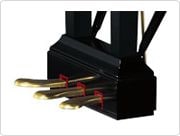Grand or Upright?
If You're Serious About Playing, a Grand Piano Is the One
"Piano" originally referred to a grand piano. The grand piano offers a wide dynamic range, rich resonance, diverse tonality, and responsive touch. Only when all of these features are combined are pianists able to fully convey the rich sound expression that composers incorporate into their works.
Features of the grand piano include:
- More rich and varying sonority with wide dynamics-from pianissimo to fortissimo
- Smoother sustain
- More substantial tone
- Higher ability to add subtle expression to notes
- Sound is uniform and well balanced
- Higher ability of note repetitions
Because these features merge to create "good sound," playing a grand piano enables the pianist to add more vibrant emotional expression to the music than when playing an upright piano.
Differences Between Upright Pianos and Grand Pianos
In an upright piano, the strings are strung vertically to make the instrument more compact, which allows the piano to be played in a limited space. In contrast, the grand piano retains the shape of the original pianoforte in which the strings are strung horizontally, and has a greater potential for expression.
Differences in the action
There is a significant difference between the action mechanisms of a grand piano and an upright piano.
Grand piano
Horizontal. Because the hammers return to their rest position under their own weight, repetition, in which the notes are repeated quickly such as when playing trills, is smooth (key repetition as fast as about 14 times per second is possible).
Upright piano
Vertical. Hammers rely on springs to return to the at-rest posit ion, and so there is a limit to fast repetition such as is used when playing trills (key repetition as fast as about seven times per second is possible).
Differences in the pedals
The pedals have different functions in a grand piano and an upright piano.
Grand piano

Shift pedal (left pedal): Also called the soft pedal or una corda pedal. Shifts the entire action assembly to the right, changing not only the sound volume, but also making minute changes to the tone.
Sostenuto pedal (middle pedal): Keeps the dampers raised and away from the strings of any keys played just before depressing the pedal. This makes it possible to sustain selected notes.
Sustain pedal (right pedal): Also called the damper pedal. Dampers remain lifted even if the fingers are taken off the keys, sustaining all played notes.
Upright piano

Soft pedal (left pedal): When this pedal is pressed, all of the hammers are moved closer to the strings, reducing the sound volume.
Muffler pedal (middle pedal): Also called the practice pedal. A thin piece of felt is dropped between the hammers and strings, greatly muting the sound.
Sustain pedal (right pedal): Also called the damper pedal. Dampers remain lifted even if the fingers are taken off the keys, sustaining all played notes.
Musical Instrument Guide : Piano Contents
Origins
Structure
How to Play
How the Instrument is Made
Choosing an Instrument
Care and Maintenance
Trivia
- The White Keys and Black Keys Were Reversed on Pianos in Mozart's Day
- Did Mozart's Piano Have a Pedal-Board?
- Piano with Automatic Accompaniment System in Beethoven's Day
- The Pianos Beloved by the Great Master, Sviatoslav Richter
- The Optimal Material for Piano Frames Is Also Ideal for Motorcycle Engines
- The Piano Soundboard Is a Board that Also Stops Vibrations
- Why Can't There Be More Than 88 Keys on a Piano?
- Why a Grand Piano Keyboard Feels Heavier Than an Upright Keyboard?
